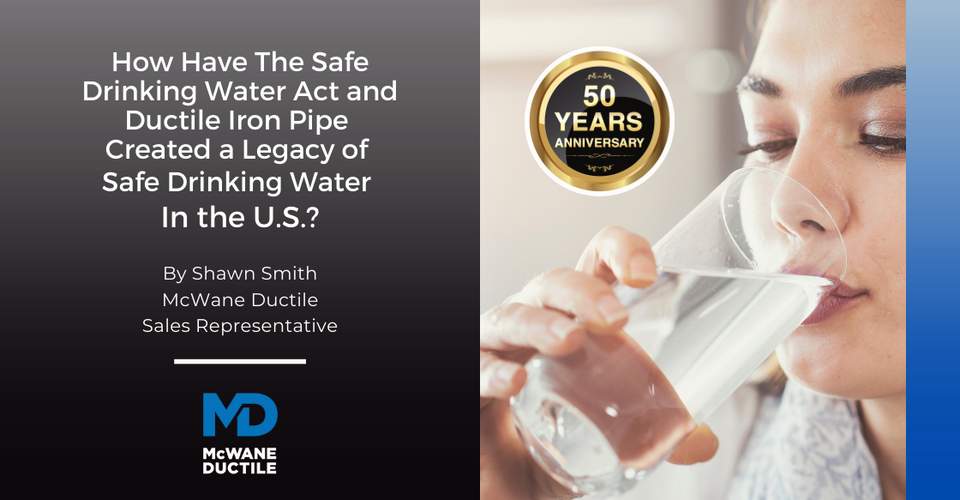Every day, millions of Americans turn on their faucets and receive safe, reliable drinking water. However, only a few realize just how much goes into the safe drinking water they are accustomed to. According to the 2023 U.N. World Water Development Report1, around two billion people, or one in every four people on earth, do not have access to safe drinking water. Additionally, due to increased flooding and other natural disasters, around 3.5 billion people also live under water stress, where the demand for clean drinking water exceeds the available amount. In the United States, we celebrate National Water Quality Month each August. This year is also a special year for water quality as it marks the 50th Anniversary of the Safe Drinking Water Act being signed into law. In this Iron Strong Blog, we will discuss the history of the Safe Drinking Water Act and how Ductile iron pipe (DI pipe) has played an integral part in improving drinking water quality in the United States.
The History of The Safe Drinking Water Act
The Safe Drinking Water Act was created to protect the drinking water supply and its sources from both naturally occurring and human-made contaminants. It sets limits on acceptable contamination levels and gives the Environmental Protection Agency (EPA) the authority to set and enforce the standards necessary to ensure safe drinking water.
President Gerald Ford signed The Act into law on December 16th, 1974. The Safe Drinking Water Act designates standards into two groups: Primary and Secondary Drinking Water Regulations.
According to the EPA2, Primary Drinking Water Regulations are "legally enforceable primary standards and treatment techniques that apply to public water systems." Primary Drinking Water Regulations focus on the safety of the water we drink and the contaminant levels within our water systems. They consist of the following categories:
- Microorganisms
- Disinfectants
- Disinfection Byproducts
- Inorganic Chemicals
- Organic Chemicals, except for PFAS
- PFAS (per-and poly-fluoroalkyl substances)
- Radionuclides
Secondary Drinking Water Regulations, on the other hand, are focused on managing the aesthetic of our drinking water, such as its taste, color, and smell. These are non-mandatory water quality standards and are not enforceable by law. Secondary Drinking Water contaminants are not considered a risk to human health.
The Safe Drinking Water Act Amendments and Changes Through The Years
The Safe Drinking Water Act has had two significant amendments throughout its history. In 1986, the Safe Drinking Water Act was amended to make several key additions to the law. It required the EPA to issue regulations for 83 specified contaminants by 1989. It also required the EPA to issue rules on 25 contaminants every three years moving forward.
This amendment significantly expanded the list of regulated contaminants from the 22 previously listed. It set forth public reporting requirements for the EPA regarding disinfection and filtration of public water systems, requiring the EPA to publish the regulations publicly. It added limits for using lead pipes and lead solder in new drinking water systems, created a wellhead protection program around public well systems, and other programs to help water utilities nationwide.
- To learn more about the disinfection of potable water mains using Calcium Hypochlorite, see this Iron Strong Blog by my colleague Bob Hartzel: What is the Purpose of Calcium Hypochlorite Granules?
The second amendment, in 1996, helped to amend the regulatory schedule of the 1986 amendments. Instead of continuing to add to the list of related contaminants, the new amendment focused on addressing contaminants that posed the greatest health risks. It also established the Drinking Water State Revolving Fund, a federally managed fund that states utilize to help water systems make infrastructure and management improvements to their water systems. The 1996 amendment also required water operator certification to ensure that all systems are operated safely within the set forth guidelines. Water utilities must also prepare yearly water quality reports for their residents. These reports include information on detected contaminants, possible health effects, and the utility’s source water.
Outside of amendments to the law itself, technological changes over the last 50 years have significantly changed the Safe Drinking Water Act. The contaminant testing technology available today can test in parts per trillion instead of parts per million like in the past. This new technology can give us significantly better insight into what’s really in our water systems, now detecting contaminants previously left untouched by regulatory scrutiny.
- What do you do if your Ductile iron pipeline's Bacteriological Test (Bac-T) fails? Find out in another Iron Strong Blog by my colleague, Chris Howe: How to Address a Failed Bacteriological Test (Bac-T) in Your Ductile Iron Pipeline.
Ductile Iron Pipe and Safe Drinking Water
The American Water Works Association's 2023 State of the Water Industry Report3 highlighted that the number one challenge determined by water utility respondents was rehabilitation and replacement of aging infrastructure. As aging water delivery pipelines are considered for replacement, perhaps in an accelerated manner due to age, it is imperative that materials be selected that align with maintaining and even enhancing safe drinking water parameters. Ductile iron, a material commonly used in water infrastructure, is not only good for the environment due to being made with 90% recycled material, but it also does not contain any Primary Drinking Water Regulation contaminants that would affect the safety of the consumer. This is evident by the fact that some iron pipe water systems have served consumers for more than 150 years.
Although iron is listed as a Secondary Drinking Water Regulation contaminant, Ductile iron pipe is lined with cement. The iron does not directly contact the water system itself. While the original intent of adding cement lining was to protect the pipes from tuberculation, a bacterial-based oxygen-driven form of corrosion that causes ferrous oxide deposits from the water on the inside of the pipe, cement lining also improved the color and taste of drinking water.
However, ingredients used to manufacture other materials currently utilized for drinking water pipelines fall under the Primary Drinking Water Regulations. For instance, vinyl chloride, one of the main ingredients in polyvinyl chloride (PVC) drinking water pipes, is listed as a primary drinking water regulation contaminant and a volatile organic chemical. Vinyl Chloride has a maximum contamination level of .002 mg/L. According to the EPA's website, the sources of contamination in drinking water are "leaching from PVC pipes and discharge from plastic facilities."
Organic Chemicals, except for PFAS
| Contaminant | MCLG1 (mg/L)2 | MCL or TT1 (mg/L)2 | Potential Health Effects from Long-Term Exposure Above the MCL (unless specified as short-term) | Sources of Contaminants in Drinking Water |
| Vinyl Chloride | zero | .002 | Increased risk of cancer | Leaching from PVC pipes; discharge from plastic factories |
Another concern with the use of plastic pipes is permeation. Unlike other poly alternatives, Ductile iron pipe is not susceptible to permeation. With utilization of an appropriate gasket material, DI pipe protects water supplies from potential ground permeation from contaminants in the surrounding soil.
Conclusion – Proper Selection of Pipe Materials is Critical
In this Iron Strong Blog, we covered the history of the Safe Drinking Water Act and how Ductile iron pipe has played and will continue to play an integral part in improving drinking water quality across the country. Not only water but safe drinking water free of contaminants is crucial to all life on the planet. For the past 50 years, the Safe Drinking Water Act and its regulations have helped ensure that water utilities and municipalities have the guidelines in place to provide safe drinking water to their residents. It has allowed us to take that safe drinking water for granted, unlike so many worldwide who are not afforded that luxury. Ductile iron plays a huge role in providing safe drinking water to our communities with its recycled material, no chemical additives, and history of sustainability. The Safe Drinking Water Act and a recent bi-partisan investment in water infrastructure spending will ensure quality drinking water for the next 50 years and beyond.
Need Assistance with Your Waterworks Project?
If you have any questions regarding your water or wastewater infrastructure project, your local McWane Ductile representative is equipped with the expertise to assist you. Many of our team members have managed small and large water utility systems, served in engineering consulting firms, and bring decades of experience solving field issues involving pipeline construction and operation. From design to submittal to installation, we strive to educate and assist water professionals throughout the water and wastewater industry.
Check Out All Our Digital Offerings
REFERENCES
- United Nations. U.N. World Water Development Report, 2023. Accessed August 26, 2024. https://www.unwater.org/publications/un-world-water-development-report-2023.
- United States Environmental Protection Agency. Drinking Water Regulations and Contaminants, 2024. Accessed August 26, 2024. https://www.epa.gov/sdwa/drinking-water-regulations-and-contaminants.
- American Water Works Association. State of the Water Industry Report, 2023. Accessed August 26, 2024. https://www.awwa.org/Professional-Development/Utility-Managers/State-of-the-Water-Industry.







